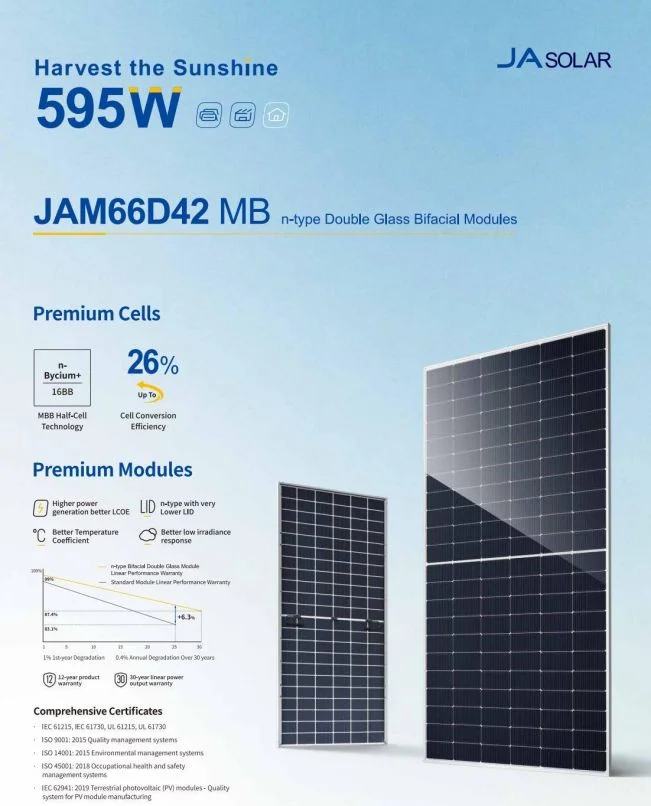The Benefits and Applications of Bifacial Solar Panels
Bifacial Grade A Solar Panel are the best solar panels to have in 2025

Part of Jinko Solar Panel
Grade A Jinko Solar Panel
Bifacial solar panels are quickly gaining popularity due to their ability to generate electricity from both the front and the rear sides of the panel. This dual-sided functionality significantly enhances their efficiency, making them a smart investment for both residential and commercial applications. In this blog post, we'll explore what bifacial solar panels are, their benefits, how they work, and the factors to consider when choosing them.
What Are Bifacial Solar Panels?
Bifacial solar panels are specially designed to capture sunlight from both sides. Unlike traditional solar panels, which only absorb light from the front, bifacial panels use transparent materials on the back to harness reflected sunlight, also known as albedo effect. This innovative technology allows them to produce more energy, even in shaded areas.
How Do Bifacial Solar Panels Work?
Bifacial solar panels utilize photovoltaic cells on both sides, converting sunlight into electricity. The front side efficiently captures direct sunlight, while the rear side captures light that is reflected off surrounding surfaces, like soil, concrete, or water. This allows for increased energy production, especially in areas with high albedo surfaces.
Key Components of Bifacial Solar Panels
**Transparent Backing**: The rear side is often made of glass, allowing sunlight to penetrate and maximize energy capture.
- **Dual-Sided Photovoltaic Cells**: These cells are engineered to optimize light absorption from both sides.
- **Advanced Racking Systems**: To maximize performance, bifacial panels are often installed on elevated structures, allowing them to capture reflected light efficiently.
Advantages of Bifacial Solar Panels
1. **Higher Efficiency**: Bifacial solar panels can produce up to 25% more energy compared to their monofacial counterparts, depending on their installation conditions.
2. **Longer Lifespan**: With reduced thermal stress and improved cooling, bifacial panels generally have a longer lifespan, leading to better ROI.
3. **Versatile Installation Options**: They can be effectively used in various applications, including rooftops, ground-mounted systems, and large-scale solar farms.
4. **Sustainability**: The enhanced efficiency means that less solar panel area is needed to generate the same level of power, thus conserving resources.
5. **Aesthetic Appeal**: Bifacial panels often look sleeker and more modern than traditional solar panels, benefiting aesthetics in residential areas.
Applications of Bifacial Solar Panels
Residential Use
Bifacial solar panels can be installed on rooftops, especially where space is limited. They can capture sunlight reflected from nearby surfaces, increasing energy generation without additional land use.
Commercial Use
Many businesses opt for bifacial panels in their solar installations to capitalize on their efficiency and reduced space requirements. From parking canopies to solar farms, bifacial panels maximize energy output.
Utility-Scale Projects
Large solar farms can particularly benefit from bifacial technology. By installing these panels in a layout that maximizes the albedo effect, utility companies can significantly boost energy production and efficiency.
Factors to Consider Before Choosing Bifacial Solar Panels
1. **Installation Environment**: Assess the grounds around the installation site. Highly reflective surfaces, such as concrete or white roofs, will yield better results.
2. **Initial Costs**: Bifacial panels may have a higher upfront cost compared to traditional panels, but their increased output can justify the investment over time.
3. **System Compatibility**: Ensure compatibility with existing solar systems and inverters, as bifacial panels may require specialized setups.
4. **Mounting Design**: An elevated mounting system can enhance the performance of bifacial panels by maximizing sunlight reflection.
5. **Location**: Areas with high solar insolation and reflective surfaces will see greater energy benefits from bifacial technology.
Conclusion
In conclusion, bifacial solar panels present an innovative solution for increasing solar energy generation efficiency. With their ability to capture light from both sides and harness reflected sunlight, they offer numerous advantages over traditional solar panels. Their long lifespan, versatility, and aesthetic appeal make them a worthwhile consideration for anyone looking to invest in solar energy solutions. As demand for renewable energy continues to grow, bifacial solar panels are poised to play a significant role in the future of solar technology.
Call to Action
If you're considering upgrading your solar energy system, reach out to a professional installer today to learn more about bifacial solar panels and how they can benefit your energy needs. By investing in this technology, you could maximize your energy savings and contribute to a more sustainable future.
